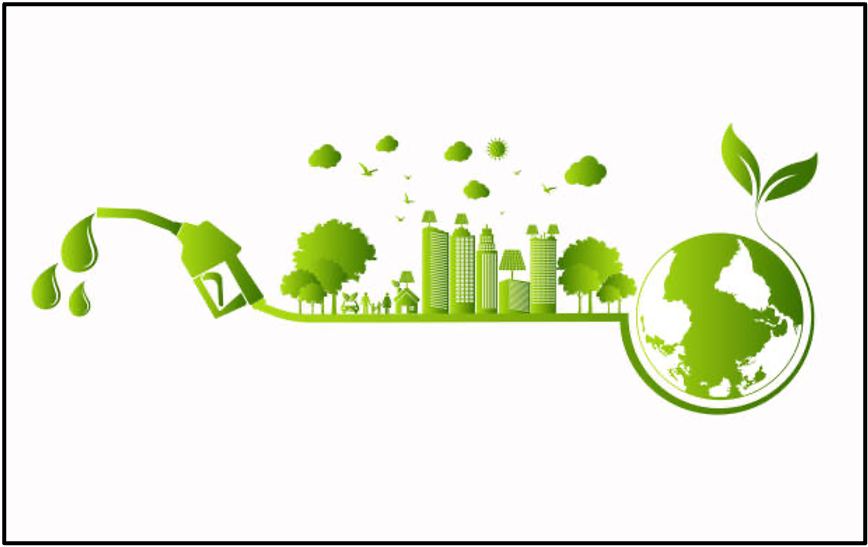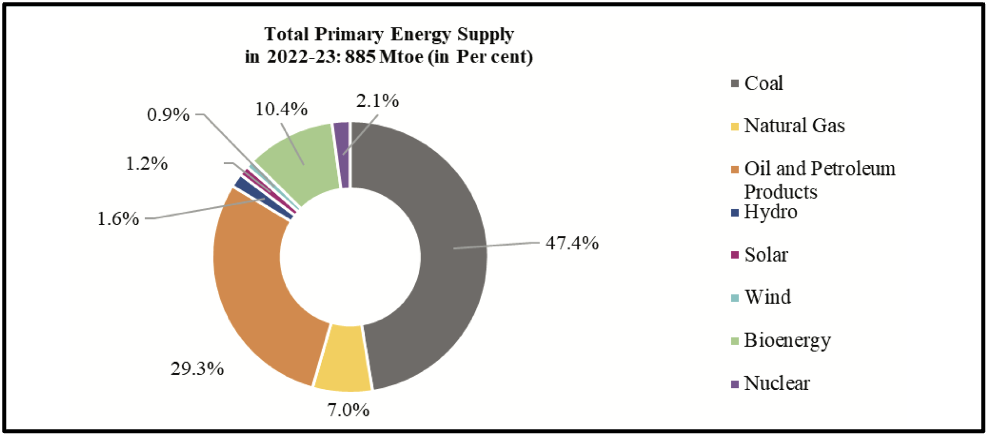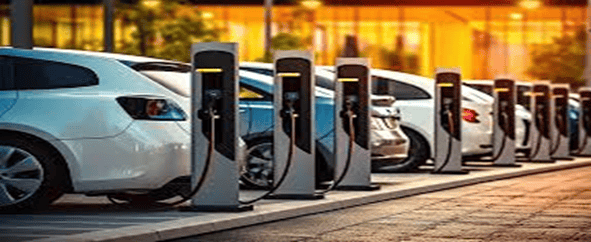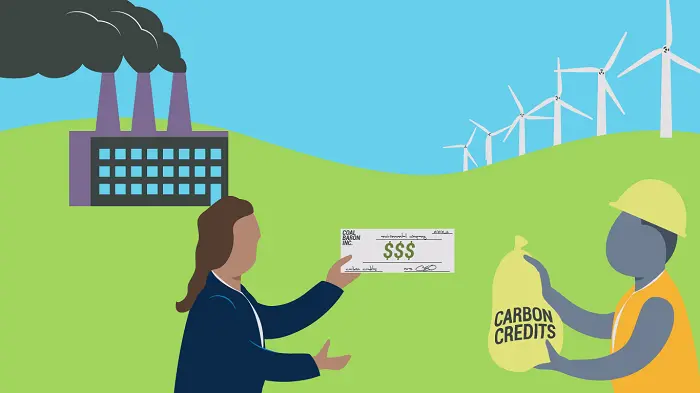The Economic Survey 2024 puts forth India’s stance in an intelligent manner and brings in various data that show the on-ground actuality of the transition. It brings to the fore a few caveats that have been explored here.
India’s annual carbon emissions are only about one-third of the global average. Being an energy-import dependent economy, this figure speaks to India’s commitment on having access to a low-carbon pathway as a non-negotiable for development. The Economic Survey 2024, released by the Finance Ministry of the Government of India, posits that this will be a part of India’s Viksit Bharat@2047 and Net-Zero@2070 ambitions.

Difficult Trade-Offs
The 1990s were a time of tectonic shifts in Indian policy. The Rio Summit of 1992 set the tone for actionable climate change schemes. This was seen in India in the rise of the then Ministry of Environment and Forests. Climate change, for India, will be a gargantuan task to undertake. India is the most populated country in the world. It has a landmass of 3.28 million sq.km – meaning – 2.5% of the world’s landscape area and 4% of the world’s freshwater resources. This makes it one of the world’s only 17 mega-biodiverse hotspots. India experiences 6 seasons and most of the economy is configured around them. Seasonal activity, seasonal labour and seasonal flows of investment have shaped the contours of the Indian economy. Owing to the size of India and the sheer diversity of ecology, no one-size-fits all approach will work. Extrapolating this point, many policy-makers across the globe are realising that recent approaches to tackling climate change are not effective either. Many countries are falling short in meeting their goals that they proclaimed at the COP conferences. The UK delayed its ban on coal-driven vehicles from 2030 to 2035. China was absent at the COP28 held in the United Arab Emirates. The question of phasing out of fossil fuels was skirted around because policymakers are now realising that they cannot jettison the expense and the time that a transition to greener fuel will take.
To choose greener fuels, there will be some trade-offs. Greener fuels require their own infrastructure that will take up a large part of the available land. The cost of making of this will skyrocket considering there are fewer available resources. Moreover, these scarce resources are unevenly distributed, making the supply chain from the producer to the consumer long, arduous, and expensive. Metals such as nickel, copper, cobalt and others are concentrated in limited areas and need extensive mining to be recovered. Ed Conway opined that the world might need more copper in the upcoming years than ever used in the history of mankind. This will place a large cost estimate on the heads of nation-states.

Potential Bottlenecks
Most green energy initiatives do not necessarily meet the estimated time and money blueprints. In fact, most overshoot their expected timelines and cause a financial stretch to the countries. Since many governments are still recovering from the COVID pandemic, bearing such costs seem unfeasible. The green projects are usually unable to meet their estimated timelines because a larger part of their requirements is complex and takes time to procure. This results in a supply chain bottleneck. Adding to this the processing time of those renewable resources, we are not too far away from the research that says a transition from a fuel-based economy to a green-fuel based economy will take close to 50-60 years (Vaclav Smith, 2014).
Geopolitical crises add another flavour to this debate. The availability of greener fuels are subject to the hegemony prevalent. The prominence of a few countries makes the securing of important minerals a tough task. More so, the various sanctions imposed on developing countries ask them to choose between improving their standard of living and providing a greener planet. Then, are the ethics different for the developing and the developed countries? The developed countries usually lead the charge for important global programs and influence the decision-making. Their ability to execute their influence comes from a glaring asymmetry of monetary resources and natural resources. Developed countries have long depended on fossil fuel-based progress for their sustenance, and asking them to slash those time-and-tested methods would not fare well. The International Renewable Energy Agency (IREA) gives a background on the energy import-export calculus of various nations. According to the IREA, 116 countries are net importers for oil, 112 countries are net importers for natural gas and another 112 countries are net coal importers. This heavy dependence on coal-based industrial progress makes the decoupling process a matter for the long haul.
Another trade-off to consider for a smooth transition is the loss of revenue the governments will experience when the economy slowly shifts from being fossil fuel-based to green-fuel based. Fossil fuels are heavily taxed by various governments, and a shift will slash their revenue and increase the other costs too. Most governments are facing a cash-flow crunch owing to a globally high inflation and reduced lending by multilateral banks. Even if the governments dig up their reserves and manage to implement a greener-fuelled economy, the returns on this investment will be slow and the government will need to carry this debt for at least the next 60-70 years (JP Morgan, 2023).
EU’s Carbon Tax
The European Union introduced a carbon-tax for the goods that are made from fossil fuels. This was hoped to discourage countries from using fossil-fuel based production techniques but instead has driven up the costs of climate finance and induced losses by $600 million (Politico EU, 2024). Ideally designed to equalise the playing field by nudging the partners of the EU to implement stricter climate policies, this increased cost will be borne by the European manufacturers which might incentivise them to move their production centres overseas. While this is still limited in its policy, India and China have shown great caution in choosing the sectors that would be a part of this.
The other alternatives such as nuclear energy, carbon capture use storage and green hydrogen come with their share of scepticism. A few countries – Japan led by Hiroshima and Nagasaki – are against the introduction of nuclear power for commercial use, rightfully so. This would also require a deeper inspection of the nuclear policies of every government. A clinical analysis of such policies will show the present and potential capability of housing such a strong energy source. Many governments would rather choose to err on the side of caution.
How India is faring
India has taken decisive steps that are in line with its capabilities and do not blow the existing structure out of balance. Micro-irrigation has been promoted under the Pradhan Mantri Krishi Sinchayee Yojana (PMKSY). The International Energy Agency (IEA) has estimated that India will need $160 billion every year to transform into a green economy. The Budget of 2024 allocated an outlay of ₹19,600 crores for the transformation to a low-carbon economy via green hydrogen.

India’s energy needs are expected to increase between 2-2.5% by 2047 and in an effort to reduce dependence on carbon, the Pradhan Mantri Surya Ghar Yojana, with an outlay of ₹75,021 crores, is expected to 30 GW of Solar capacity and add 17 lakh direct jobs in the solar supply chain (Government of India, 2024). Biomass occupies a large share in India’s energy composite and that is set to change with the advent of more solar energy. India is also looking to enhance the Energy Efficiency Index by reducing the Emissions Intensity (EI) by 45% by 2030. A primary contributor to this would be the building sector and an Energy Conservation Building Code (ECBC) has been set in place to monitor standards for commercial buildings. In 2022-2023, this helped save 81 billion units of electricity.
Leaner climate finance will drive climate change. Availability, accessibility and affordability will make climate-oriented actions pervasive. India has been adhering to the objectives of the Paris Agreement and the United Nations Framework Convention on Climate Change (UNFCCC) while considering the limitations of its partners too. While, Kofi Annan may have said that climate change is perceived as a problem for the further but India’s actions show her steadfastness and farsightedness.
Written by Shashwathi Shankar
Edited by Aliya Khatri




